Chakra meditation enhances energy alignment and fosters spiritual growth. It promotes balance and emotional well-being while increasing self-awareness and clarity. Techniques such as visualization, breath control, and sound vibrations support this practice. Overcoming common challenges like concentration and emotional blockages can elevate the meditation experience.
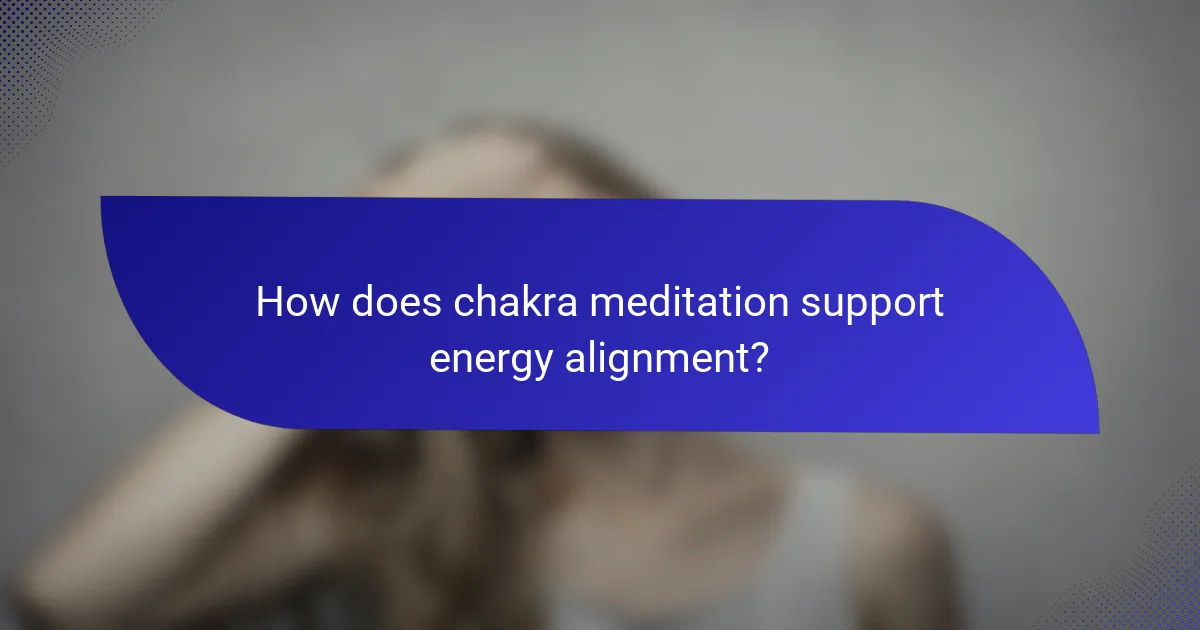
How does chakra meditation support energy alignment?
Chakra meditation effectively supports energy alignment by harmonizing the body’s energy centres. This practice enhances spiritual growth by promoting balance and emotional well-being. Regular engagement with chakra meditation can lead to increased self-awareness and clarity, fostering a deeper connection to one’s inner self. Additionally, it can help release blockages, allowing for a smoother flow of energy throughout the body.
What are the key principles of chakra meditation?
Chakra meditation focuses on aligning energy centres to promote spiritual growth and well-being. Key principles include breath control, visualization, and sound vibrations. Practitioners often concentrate on each chakra’s unique attributes, such as colour and sound, to enhance energy flow. This practice fosters self-awareness, emotional balance, and connection to higher consciousness.
How do chakras influence physical and emotional health?
Chakras significantly influence physical and emotional health by regulating energy flow within the body. Balanced chakras promote overall well-being, while blockages can lead to physical ailments and emotional distress. Chakra meditation enhances energy alignment, fostering spiritual growth and emotional stability. Engaging in this practice can improve mental clarity, reduce stress, and enhance emotional resilience. Each chakra corresponds to specific physical and emotional aspects, highlighting their unique attributes in health.
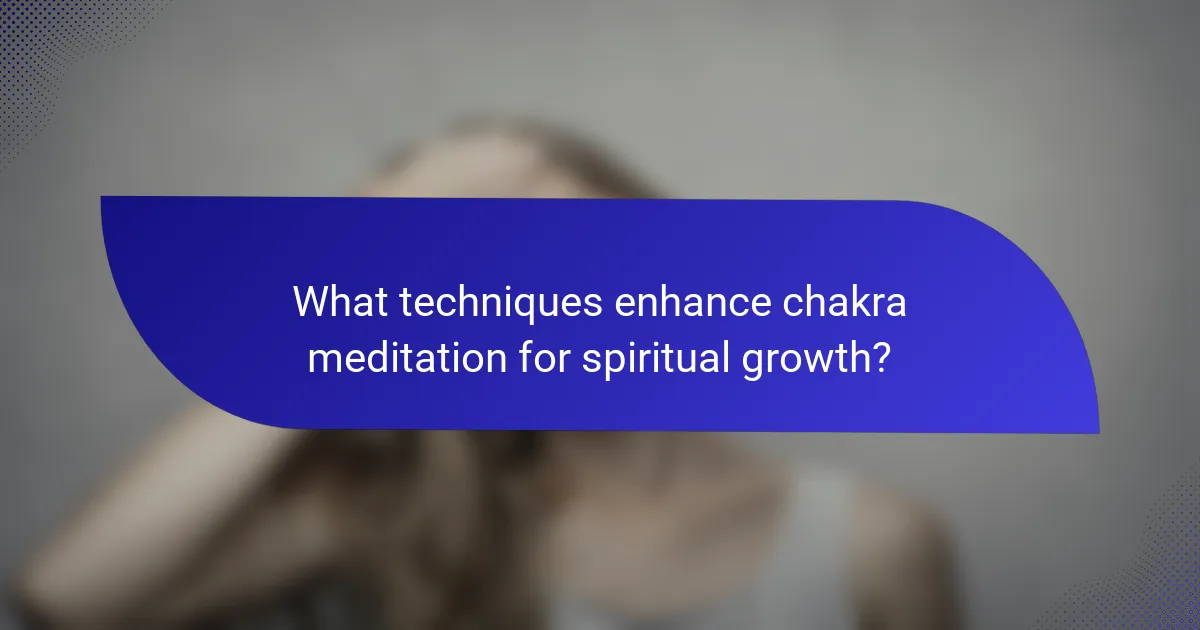
What techniques enhance chakra meditation for spiritual growth?
Techniques that enhance chakra meditation include visualization, breath control, sound vibrations, and mindful movement. These methods promote energy alignment and support spiritual growth.
Visualization focuses on imagining each chakra’s colour and energy, enhancing awareness. Breath control involves deep, rhythmic breathing to centre the mind and body. Sound vibrations, such as chanting or using singing bowls, resonate with chakra frequencies, promoting healing. Mindful movement, like yoga, integrates body awareness and energy flow, deepening the meditation experience.
Incorporating these techniques can significantly elevate the effectiveness of chakra meditation, fostering deeper spiritual connections and personal growth.
Which meditation practices are most effective for chakra alignment?
Meditation practices that effectively align chakras include Kundalini meditation, guided visualization, and sound healing. Each practice targets specific energy centres, promoting balance and spiritual growth.
Kundalini meditation activates dormant energy at the base chakra, facilitating a transformative experience. Guided visualization allows practitioners to focus on each chakra, enhancing awareness and energy flow. Sound healing utilises frequencies, such as singing bowls, to resonate with chakras, fostering healing and alignment.
Regular practice of these techniques can lead to improved emotional well-being and spiritual clarity. Integrating these methods into a daily routine enhances overall energy alignment.
How can breathwork amplify the effects of chakra meditation?
Breathwork enhances chakra meditation by facilitating deeper energy flow and emotional release. This practice aligns breath with intention, amplifying the meditative state. By focusing on breath patterns, practitioners can activate specific chakras, promoting balance and spiritual growth. Breathwork also helps clear mental distractions, allowing for a more profound connection to inner energy. Integrating breathwork into chakra meditation can lead to heightened awareness and transformative experiences.
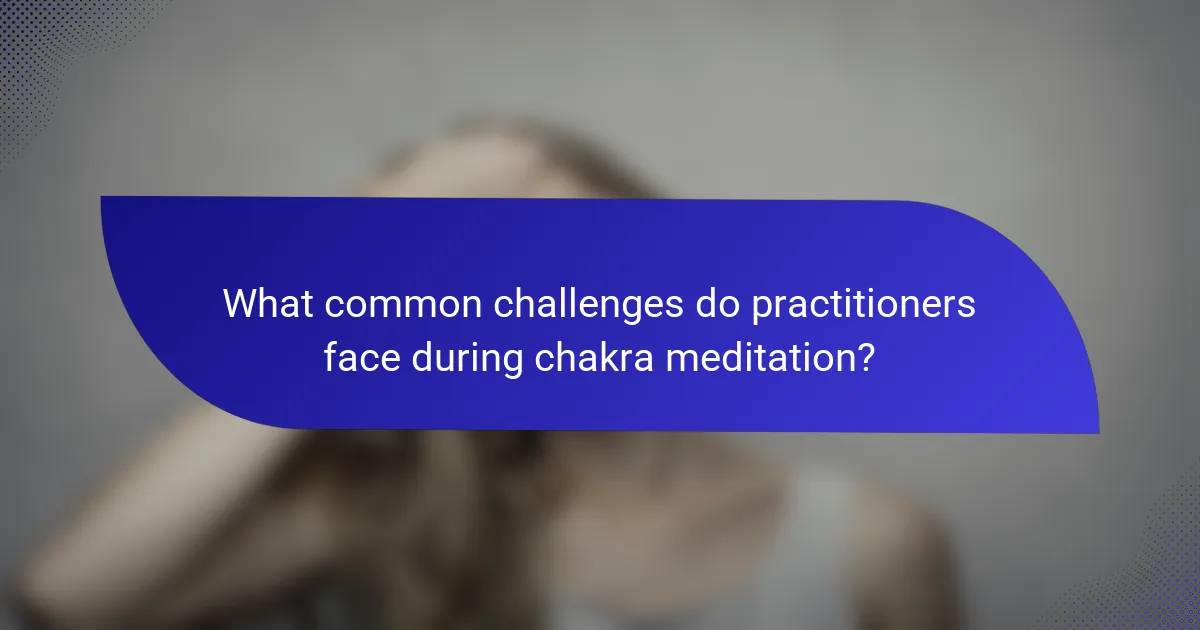
What common challenges do practitioners face during chakra meditation?
Practitioners of chakra meditation often face challenges such as difficulty in focusing, emotional blockages, and physical discomfort. These obstacles can hinder energy alignment and spiritual growth.
One common challenge is maintaining concentration during meditation, which can be disrupted by intrusive thoughts or external distractions. Emotional blockages may arise, preventing the free flow of energy through the chakras, leading to feelings of frustration. Additionally, practitioners may experience physical discomfort, such as tension or pain, particularly in the areas associated with specific chakras.
Overcoming these challenges requires consistent practice and techniques such as breath control, visualization, and grounding exercises. Practitioners can enhance their experience by creating a dedicated meditation space and using supportive tools like crystals or essential oils.
How can distractions be minimized during meditation sessions?
To minimize distractions during chakra meditation, create a dedicated space, use calming music, and focus on breath. Establishing a routine enhances concentration.
1. Choose a quiet environment free from interruptions.
2. Use meditation cushions for comfort and stability.
3. Set a specific duration for each session to prepare mentally.
4. Practice mindfulness techniques to refocus when distractions arise.
5. Incorporate visualization of chakras to deepen engagement.
6. Limit digital distractions by turning off devices.
What are effective strategies for overcoming mental blocks?
Chakra meditation effectively overcomes mental blocks by promoting energy alignment and enhancing spiritual growth. This practice focuses on balancing the body’s energy centres, which can release tension and clear mental fog.
Engaging in chakra meditation involves visualising each chakra, starting from the root and moving upward. This process can help identify and dissolve specific mental barriers. Regular practice fosters a sense of clarity and peace, leading to improved focus and creativity.
Incorporating breathwork during meditation amplifies its benefits. Deep breathing techniques can further enhance energy flow, aiding in the release of negative thought patterns. As a result, practitioners often experience heightened awareness and emotional stability.
Ultimately, chakra meditation serves as a powerful tool for personal development. By aligning energy centres, individuals can unlock their potential and navigate through mental obstacles with greater ease.

Which tools and resources can aid chakra meditation practice?
Meditation apps, guided recordings, and chakra crystals enhance chakra meditation practice. These tools help focus energy alignment and support spiritual growth.
Mindfulness apps like Headspace or Insight Timer offer guided sessions tailored to chakra work. Crystal healing can involve stones like amethyst or citrine, each corresponding to specific chakras.
Books and online courses provide in-depth knowledge on chakra systems and meditation techniques. Community groups or workshops can foster shared experiences and insights.
What role do crystals play in chakra meditation?
Crystals enhance chakra meditation by promoting energy alignment and spiritual growth. They resonate with specific chakras, amplifying their healing properties. For example, amethyst supports the crown chakra, fostering spiritual awareness. Using crystals during meditation can deepen the experience and facilitate emotional release. Selecting the right crystal for each chakra is essential to maximise benefits.
How can guided meditations enhance the experience?
Guided meditations enhance chakra meditation by facilitating deeper energy alignment and promoting spiritual growth. These meditations provide structured guidance, helping practitioners focus on each chakra’s unique attributes. By using visualization and affirmations, guided sessions can amplify the benefits of chakra work, such as increased emotional balance and heightened awareness. Additionally, they can introduce techniques to release blockages, making the journey toward spiritual growth more effective and transformative.
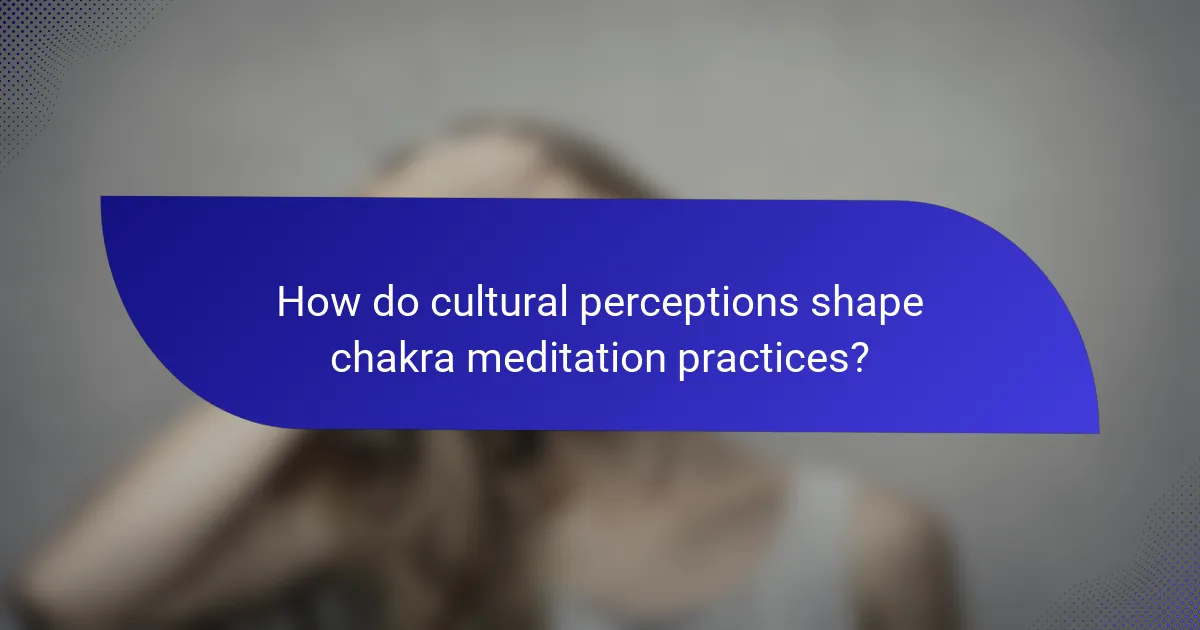
How do cultural perceptions shape chakra meditation practices?
Cultural perceptions significantly influence chakra meditation practices by shaping beliefs, techniques, and goals. Different cultures emphasize various chakras and their associated energies, impacting the meditation experience. For instance, Western practices often focus on personal empowerment and emotional healing, while Eastern traditions may prioritise spiritual enlightenment and balance. This variation illustrates how cultural contexts create unique interpretations of chakra meditation, affecting how practitioners engage with energy alignment and spiritual growth.
What variations exist in chakra meditation across different cultures?
Chakra meditation varies significantly across cultures, each emphasizing unique aspects. In Hinduism, it focuses on energy centres for spiritual growth and self-awareness. Tibetan Buddhism incorporates visualization techniques and mantras to enhance meditation. Western practices often blend chakra concepts with psychology, promoting emotional healing. Native American traditions may integrate nature and spirit connection in their approach. Each cultural variant enriches the practice, offering diverse pathways for energy alignment and personal development.
How is chakra meditation integrated into modern wellness trends?
Chakra meditation is increasingly integrated into modern wellness trends as a method for energy alignment and spiritual growth. This practice enhances mindfulness and promotes emotional balance, appealing to individuals seeking holistic health solutions.
Many wellness centres now offer chakra meditation sessions, combining traditional techniques with contemporary wellness practices. This integration helps participants connect with their inner selves and fosters a sense of community.
The rise of digital wellness platforms has also contributed to the popularity of chakra meditation. Apps and online courses provide accessible guidance, allowing users to explore energy centres at their own pace.
Research indicates that chakra meditation can reduce stress and improve overall well-being, aligning with the growing demand for effective mental health strategies. As a result, it has become a staple in the wellness industry, reflecting a shift toward more inclusive and diverse health practices.
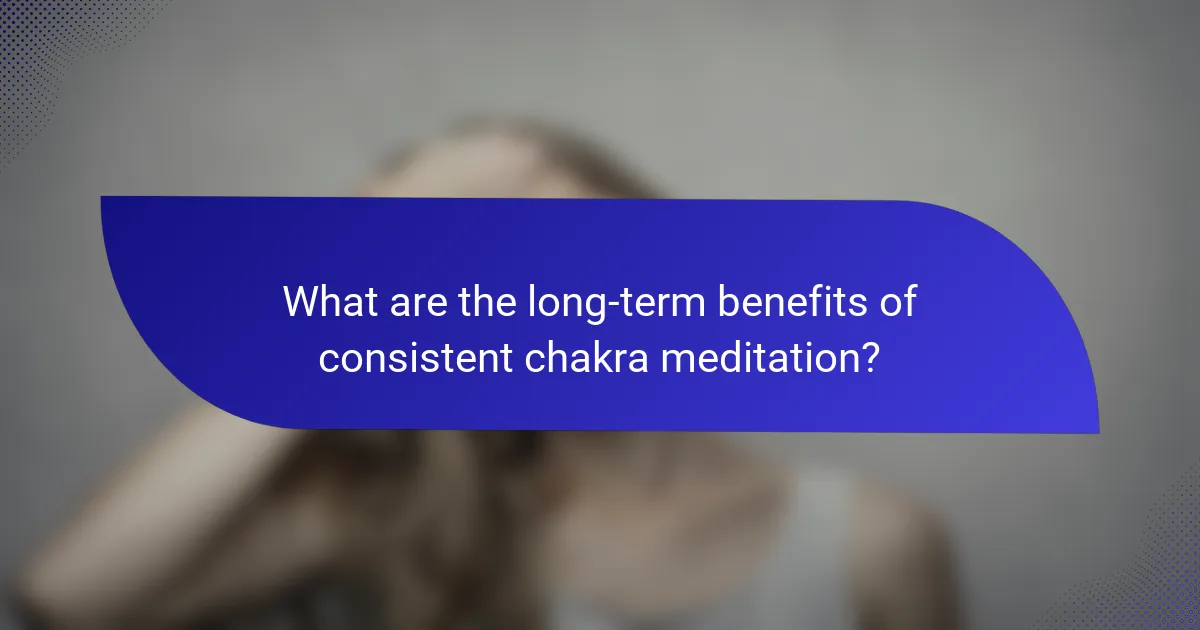
What are the long-term benefits of consistent chakra meditation?
Consistent chakra meditation offers long-term benefits such as enhanced emotional balance, improved focus, and greater spiritual awareness. This practice aligns energy centres, promoting physical and mental well-being. Over time, practitioners may experience increased resilience to stress and a deeper sense of purpose. Regular meditation fosters self-awareness, leading to personal growth and transformation.
How does chakra meditation contribute to personal development?
Chakra meditation significantly enhances personal development by promoting energy alignment and spiritual growth. This practice fosters self-awareness, emotional balance, and mental clarity, which are essential for personal transformation.
Engaging in chakra meditation allows individuals to identify and release blockages within their energy centres. As a result, this process facilitates a deeper connection to oneself and the surrounding environment. Regular practice can lead to increased intuition and a heightened sense of purpose.
Moreover, chakra meditation encourages mindfulness, which supports emotional regulation and resilience. By cultivating a focused mindset, practitioners can better navigate life’s challenges and enhance their overall well-being.
Ultimately, chakra meditation serves as a powerful tool for personal development, enabling individuals to unlock their potential and achieve a more fulfilling life.
What evidence supports the effectiveness of chakra meditation?
Chakra meditation is supported by various studies demonstrating its effectiveness in energy alignment and spiritual growth. Research indicates that regular practice can enhance emotional well-being, reduce stress, and improve focus. A study published in the Journal of Alternative and Complementary Medicine found that participants experienced significant reductions in anxiety and increased mindfulness after engaging in chakra meditation. Additionally, neuroimaging studies suggest that meditation positively alters brain activity, particularly in areas associated with emotional regulation and self-awareness. These findings highlight the potential of chakra meditation as a tool for personal development and holistic health.
What expert tips can optimize your chakra meditation practice?
To optimize your chakra meditation practice, focus on consistency, intention, and environment. Establish a regular schedule to deepen your practice. Set clear intentions for each session to enhance energy alignment. Create a calming space with minimal distractions to foster spiritual growth. Incorporate visualization techniques to engage with each chakra’s unique attributes, enhancing overall effectiveness. Consider using tools like crystals or essential oils that resonate with specific chakras for added support.